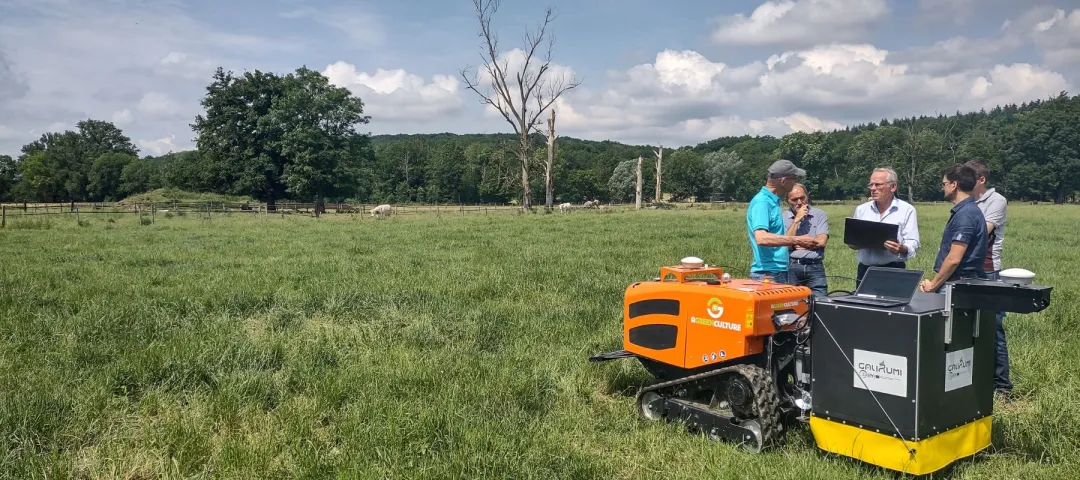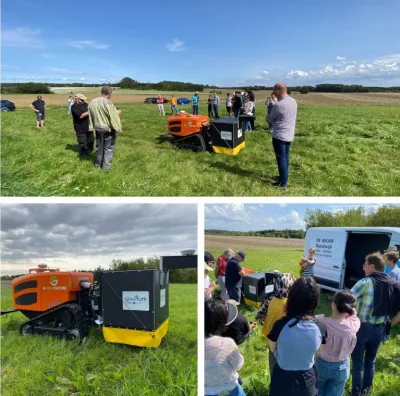Summary
Im Rahmen des GALIRUMI-Horizon-Projekts wurden 2023 Roboter für die herbizidfreie Unkrautbekämpfung in der Milchwirtschaft entwickelt. Mithilfe von Galileo, dem europäischen globalen Satellitennavigationssystem, bekämpfen sie das Unkraut Blacken. Diese fortschrittlichen Unkrauterkennungsroboter verbessern die Nachhaltigkeit von Milchviehbetrieben und können die Arbeitskosten senken.
Ressourcen
Links
Im Rahmen des GALIRUMI-Horizon-Projekts wurden 2023 Roboter für die herbizidfreie Unkrautbekämpfung in der Milchwirtschaft entwickelt. Die Roboter werden von Galileo, dem europäischen globalen Satellitennavigationssystem, bei der Bekämpfung des breitblättrigen Ampfer (Rumex obtusifolius) unterstützt. Durch den Einsatz von Robotern mit fortschrittlicher Unkrauterkennung werden Milchviehbetriebe nachhaltiger und können potenziell ihre Arbeitskosten senken.
Robotik und künstliche Intelligenz (KI) verändern die Land- und Forstwirtschaft, indem sie Innovationen fördern und die Wettbewerbsfähigkeit in verschiedenen Sektoren, einschließlich der Landwirtschaft, steigern. Gleichzeitig erleichtert die Robotik präzise Arbeitsabläufe, sodass sich Land- und Forstwirte auf hochwertige Aufgaben konzentrieren können, wodurch die Produktivität verbessert und die Nachhaltigkeit gefördert wird.
Esther López, Projektkoordinatorin des GALIRUMI-Projekts von ACORDE Technologies in Spanien, erklärt, dass die Entwicklung der Roboter von Milchbauern inspiriert wurde, die mit Unkraut auf ihren Wiesen zu kämpfen hatten. Das Unkraut von Hand zu entfernen ist arbeitsintensiv, und in einigen Produktionssystemen, wie z. B. in der ökologischen Landwirtschaft, ist der Einsatz chemischer Pestizide nicht möglich. Durch den Einsatz von Robotern wird der Bedarf an Handarbeit beim Unkrautjäten erheblich reduziert, wodurch die mit der Unkrautbekämpfung verbundenen Kosten gesenkt werden und sichergestellt wird, dass das Gras eine hohe Qualität und einen hohen Ertrag behält. In der Zwischenzeit haben die Landwirte mehr Zeit für andere Aufgaben, ohne dass die Produktivität beeinträchtigt wird.
Konkret hat GALIRUMI zwei Unkrautbekämpfungseinheiten mit zwei verschiedenen Systemen entwickelt. Die erste ist für die elektrische Unkrautbekämpfung ausgelegt und verwendet elektrische Hochspannungsschläge, um Unkraut zu beseitigen. Die zweite verwendet die Laser-Unkrautbekämpfungstechnologie. Der Roboter durchquert systematisch das gesamte Feld und nimmt Bilder auf, um das Unkraut zu identifizieren. Er verwendet einen Laser, um die Blätter des Unkrauts zu zerstören und es so effektiv zu zersetzen.
Beide Einheiten verwenden Galileo, um die genauen Standorte der identifizierten Unkräuter zu erfassen. In einer späteren Phase des Prozesses navigiert der Roboter direkt zu den gespeicherten Unkrautstandorten, bewegt sich von einem zum nächsten und beseitigt sie. Beide Systeme können an jeden Roboter oder Traktor angeschlossen werden, um Blacken zu bekämpfen. Feldvorführungen fanden in Zusammenarbeit mit Landwirten in den Niederlanden, Dänemark und Frankreich statt.
Hintergrundinformationen
Am 19. und 20. Februar 2025 organisierte das EU-GAP-Netzwerk das Seminar „Robotik und künstliche Intelligenz in der Land- und Forstwirtschaft“. Die GALIRUMI-Projektpartner waren bei diesem Seminar anwesend.
Esther López


